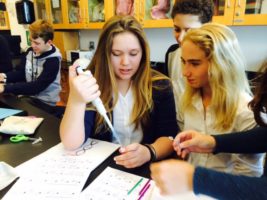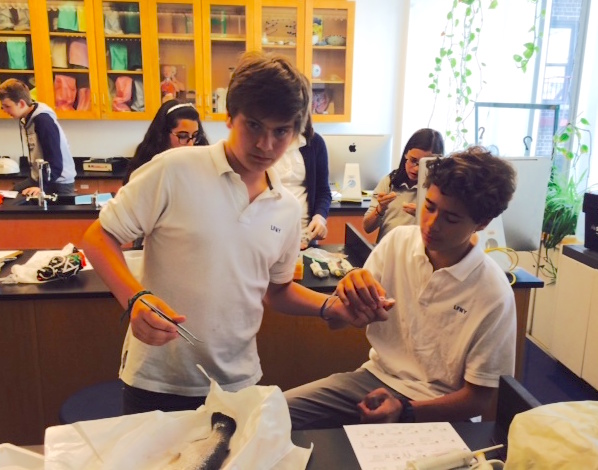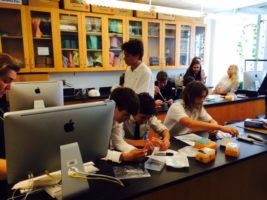Ladies and gentlemen, we have a unique kind of student on campus about whom you will be hearing a great deal more in the future, as we intensify our efforts to provide her with everything she needs to accomplish her work. Who exactly? A person some would call a “citizen scientist,” though to be honest I ought to be speaking in the plural, so numerous are these special people becoming at the Lycée Français de New York, for the immediate benefit of our learning community and I would dare say for the ultimate benefit of society at large!
To borrow a definition from the National Geographic: “Citizen science is the practice of public participation and collaboration in scientific research to increase scientific knowledge.” Aided by the continuous strengthening of democracy, particularly the ever-growing sense that even the most technical questions of our times are best addressed through broad inclusiveness and engagement, by phenomenal advances in technology, which have placed many sophisticated tools within reach of us all, and by a significant shift in the the nature of science education at many leading schools, which like ours emphasize inquiry-based learning, “community-based groups may generate ideas…Interested volunteers, amateur scientists, students, and educators may network and…advance our understanding of the world.”
Decoding the DNA of fish
Of course, for we who have the privilege of working in the field of education, the key word in this characterization is “students,” which brings me to my source of inspiration for this week’s blog: the extraordinary experience I had a few days ago when attending an eighth grade “Itinéraire de Découverte,” or interdisciplinary project-based research class, brilliantly co-taught by science teacher Sylvie Ozon and mathematics teacher Anne-Sophie Cuna, with the title: “Using DNA Barcodes to Identify and Classify Living Things.” More precisely, I had the unforgettable opportunity to observe some 20 emerging scientists in action, with so much intellectual curiosity, ingenuity and vitality among them that I am still resisting the temptation to drop everything and to join their class for the rest of the year!
These students are decoding the DNA of a fish.
To explore the role, structure, location, code, replication and other riveting dimensions of DNA, not to mention several complementary subjects from chemistry, physics and maths, our eighth graders were divided into groups of three, with each team focused on decoding the DNA of something cell-based on which they had decided together. For some, it was a coffee bean; for others, fish from the Atlantic Ocean. Passionately and collaboratively, they brought an impressive range of research tools to bear on their work, including micropipettes, polymerase chain reaction instruments, centrifugal extractors and electrophoresis equipment, while simultaneously taking notes for their personal science journals and talking with conviction about the final public research presentations they would eventually be making. Their concentration was intense; their enthusiasm palpable: our students were in that remarkable place of discovery for which we aim in every class, where time disappears and the bell is an awful, horrible, nightmarish interruption.
Yet what also struck me about the exceptional focus our students displayed was the exceptional excitement so many of them expressed about doing something which might make a difference in the world around them. What if the trees we were to identify from Central Park turned out be a new species of pine which would enrich our understanding of Manhattan biodiversity? What if the food being sold at a local shop were not what its label identified it as being? Such “what if” queries were driven by an ardor for learning in general, but also by a desire to harness the potential of science in the service of the greater good. Congratulations and bravo to these citizen scientists!
NB. This eighth grade DNA-related course is one of many projects across several grades made possible by a new partnership the LFNY has created this year with the Cold Spring Harbor DNA Laboratory, thanks to a very generous, multi-year gift to our Annual Fund by one of our families, memorably brought to life by our science faculty and given true meaning by our students.
About the Author :
Sean Lynch was Head of School at the Lycée Français de New York from 2011 to 2018, after having spent 15 years at another French bilingual school outside of Paris: the Lycée International de St. Germain-en-Laye. Holding both French and American nationalities, educated in France (Sciences Po Paris) and the United States (Yale), and as the proud husband of a French-American spouse and father of two French-American daughters, Sean Lynch has spent his entire professional and personal life at the junction between the languages, cultures and educational systems of France and the United States. In addition to being passionate about education, he loves everything related to the mountains, particularly the Parc National du Mercantour.




